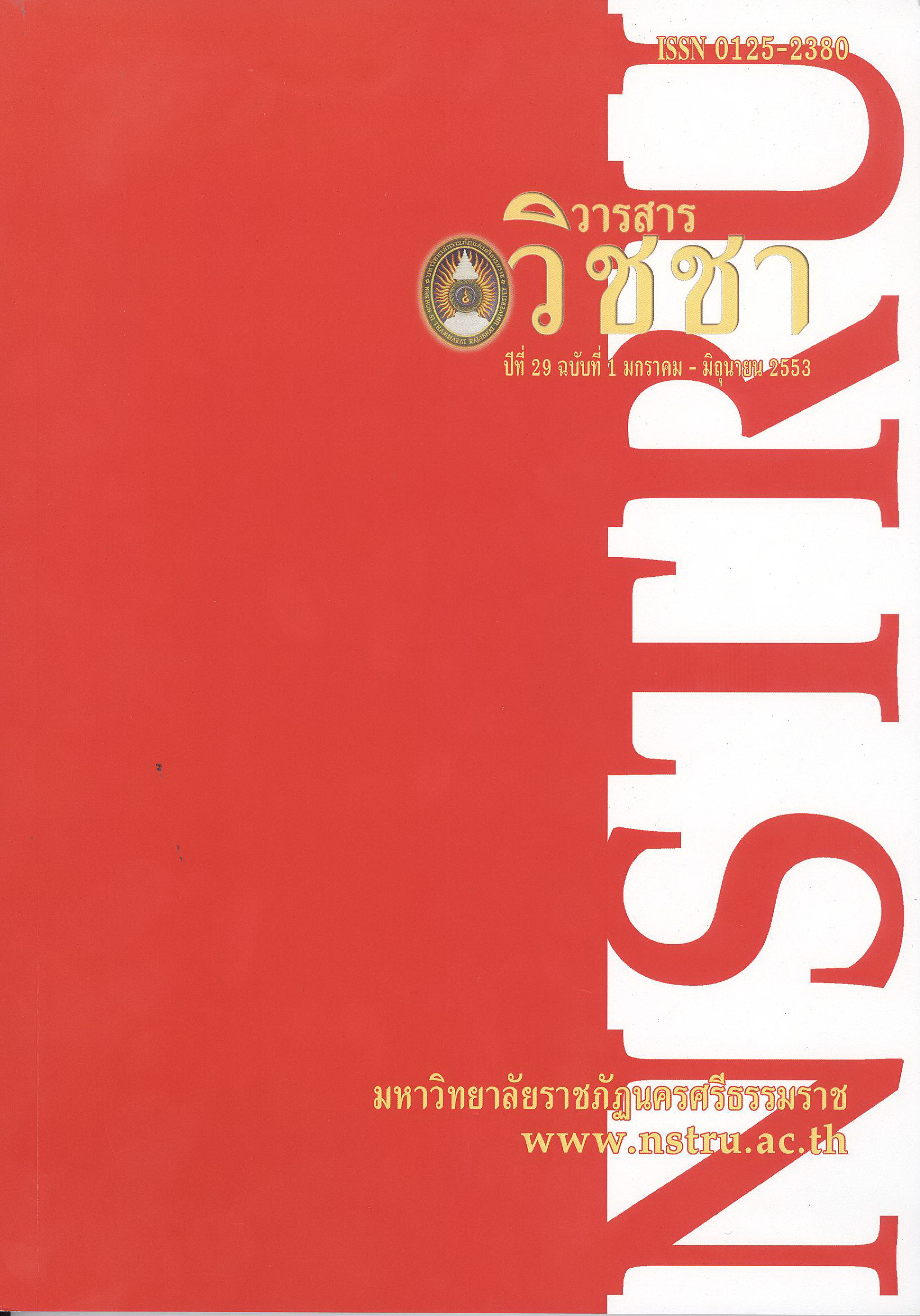การวิจัยเพื่อพัฒนาการจัดการวิสาหกิจชุมชนเพื่อการพึ่งตนเองและแก้ไขความยากจน อย่างบูรณาการในพื้นที่จังหวัดนครศรีธรรมราช : กรณีศึกษากลุ่มผลิตภัณฑ์ผ้าบาติกวัดจันทร์ ตำบลกำโลน อำเภอลานสกา
Main Article Content
บทคัดย่อ
การวิจัย เพื่อพัฒนาการจัดการวิสาหกิจชุมชนเพื่อการพึ่งตนเองและแก้ไขความยากจนอย่างบูรณาการในพื้นที่จังหวัดนครศรีธรรมราช : กรณีศึกษากลุ่มผลิตภัณฑ์ผ้าบาติกวัดจันทร์ ตำบลกำโลน อำเภอลานสกา มีวัตถุประสงค์ดังนี้ 1) เพื่อศึกษาระบบจัดการกลุ่มผลิตภัณฑ์ผ้าบาติกวัดจันทร์ ตำบลกำโลน อำเภอลานสกา จังหวัดนครศรีธรรมราชให้มีความร่วมมือกันในลักษณะโซ่อุปทาน (Supply Chain ) 2) เพื่อพัฒนาระบบจัดการทำงานกันเป็นกลุ่ม (Cluster) ผลิตภัณฑ์ กลุ่มผลิตภัณฑ์ผ้าบาติกวัดจันทร์ ตำบลกำโลน อำเภอลานสกา จังหวัดนครศรีธรรมราช 3) เพื่อพัฒนาผลิตภัณฑ์กลุ่มผลิตภัณฑ์ผ้าบาติกวัดจันทร์ ตำบลกำโลน อำเภอลานสกา จังหวัดนครศรีธรรมราช ให้สามารถเข้าสู่ตลาดสากลได้มากขึ้น และ 4) เพื่อพัฒนารูปแบบเครือข่ายการตลาด กลุ่มผลิตภัณฑ์ผ้าบาติกวัดจันทร์ตำบลกำโลน อำเภอลานสกา จังหวัดนครศรีธรรมราช เป็นการวิจัยแบบผสมสานระหว่างการวิจัยเชิงปริมาณและการวิจัยเชิงคุณภาพ โดยใช้วิธีการศึกษาเอกสาร การสัมภาษณ์แบบเจาะลึกผู้เกี่ยวข้อง และการเก็บข้อมูลกลุ่มตัวอย่างโดยใช้แบบสอบถาม
ผลการศึกษาพบว่า ระบบการจัดการกลุ่มเป็นไปอย่างหลวม ๆ ผู้ที่ดำเนินการหลักคือประธานกลุ่ม ซึ่งสมาชิกส่วนใหญ่ไม่มีส่วนร่วมในการดำเนินกิจกรรมของกลุ่ม มีการประสานงานกับกลุ่มผลิตภัณฑ์เดียวกัน โดยกระบวนการผลิตและการจัดจำหน่ายนั้นเป็นลักษณะการรับใบสั่งและการจำหน่ายผลิตภัณฑ์ในงานแสดงสินค้าทั่วไป มีการฝากขายสินค้าในร้านค้าในตัวจังหวัด ส่วนการลงทุนเป็นลักษณะเงินทุนหมุนเวียนจากกำไร และการสนับสนุนจากหน่วยงานอื่น ๆ ในด้านเครื่องจักร และความร่วมมือในการจัดซื้อวัตถุดิบจากกลุ่มเครือข่าย ด้านปัญหาอุปสรรคของกลุ่ม ได้แก่ ด้านการลงทุน การขาดแคลนฝีมือแรงงานในการผลิตและการออกแบบตัดเย็บ และขาดการประชาสัมพันธ์สินค้า ด้านผู้บริโภคพบว่าส่วนใหญ่มีความพึงพอใจในผลิตภัณฑ์ในด้านความสวยงาม ความคงทนเป็นสินค้าที่ผลิตด้วยมือ ส่วนที่ควรพัฒนา ได้แก่ ลวดลาย รูปแบบผลิตภัณฑ์ใหม่ ๆ เพื่อขยายลูกค้าไปสู่กลุ่มอื่น ๆ สำหรับแนวทางเพื่อนำไปสู่ความยั่งยืนของกลุ่มควรมีการปรับรูปแบบการบริหารจัดการเน้นการมีส่วนร่วมของสมาชิกให้มากขึ้น การฝึกอบรมฝีมือแรงงานในการผลิตและการออกแบบผลิตภัณฑ์ การพัฒนารูปแบบความสัมพันธ์ระหว่างกลุ่มผลิตภัณฑ์กับกลุ่มการผลิต หรือการแสวงหาความร่วมมือจากหน่วยงานสนับสนุนอื่น ๆและการสนับสนุนและส่งเสริมกลุ่มคนรุ่นใหม่ที่สนใจเข้ามาร่วมเป็นสมาชิกอยู่เสมอเพื่อให้กลุ่มสามารถดำเนินกิจกรรมได้อย่างยั่งยืนต่อไป
Management Development of Community Enterprise for Self and Integrated Poverty Resolution in Nakhon Si Thammarat : A Case Study Product, Batik Wat Chan Kam Lon, Lansaka.
The research on Management Development of Community Enterprise for Self and Integrated Poverty Resolution in Nakhon Si Thammarat : A Case Study of Product, Batik Wat Chan. attempted to 1) study the management system to cooporate in supply chain of Batik product at Wat Chan, Kamlon district, Nakhon Si Thammarat, 2) develop the management supply chain system as a cluster, 3) develop a product , and 4) develop a network model to market Batik products at Wat Chan, Kamlon district, Nakhon Si Thammarat. The research methodology reflected a combination of both quantitative and qualitative methods by using the review of related documents, in-depth interview, and questionnaires.
The results showed that the management of the group was a loose one led by the head of the group. The majority of the members did not participate in group activities but cooperated among the same product groups. The production and distribution were done by receiving orders and sales of products in the exhibition and local shops. Besides, the investment came from the profits from the sales of the products and other supporters regarding machinery, and the purchase of raw materials from their network. In addition, the problems of group were cited as the investment, lack of skilled labor in production, sewing, and product promotion. As for the consumers, they were satisfied with the product beauty, durability of the products, and handmade. However, the groups should develop new products and expand to new customers. In order to maintain group sustainability, the group should put emphasis on the cooperation among the members. On occasions, the training in batik manufacturing and product design should be provided. Also, the group should develop a relationship between the product clusters and the production clusters as well as seeking support from external agencies, and attracting younger generation to join the group for sustainable development in the future.
Article Details
เนื้อหาและข้อมูลในบทความที่ลงตีพิมพ์ในวารสารวิชชา มหาวิทยาลัยราชภัฏนครศรีธรรมราช ถือเป็นข้อคิดเห็นและความรับผิดชอบของผู้เขียนบทความโดยตรง ซึ่งกองบรรณาธิการวารสารไม่จำเป็นต้องเห็นด้วยหรือร่วมรับผิดชอบใด ๆ
บทความ ข้อมูล เนื้อหา รูปภาพ ฯลฯ ที่ได้รับการตีพิมพ์ในวารสารวิชชา มหาวิทยาลัยราชภัฏนครศรีธรรมราช ถือเป็นลิขสิทธ์ของวารสารวิชชา มหาวิทยาลัยราชภัฏนครศรีธรรมราช หากบุคคลหรือหน่วยงานใดต้องการนำข้อมูลทั้งหมดหรือส่วนหนึ่งส่วนใดไปเผยแพร่ต่อหรือเพื่อการกระทำการใด ๆ จะต้องได้รับอนุญาตเป็นลายลักษณ์อักษรจากวารสารวิชชา มหาวิทยาลัยราชภัฏนครศรีธรรมราชก่อนเท่านั้น
The content and information in the article published in Wichcha journal Nakhon Si Thammarat Rajabhat University, It is the opinion and responsibility of the author of the article. The editorial journals do not need to agree. Or share any responsibility.


